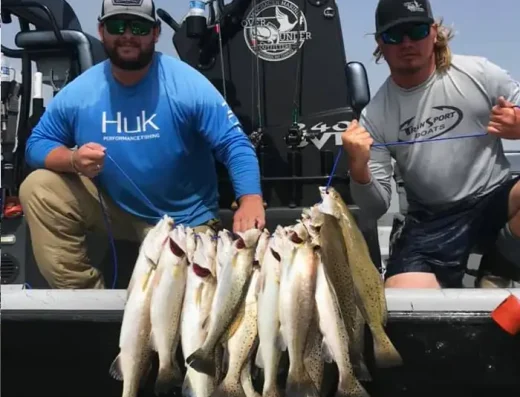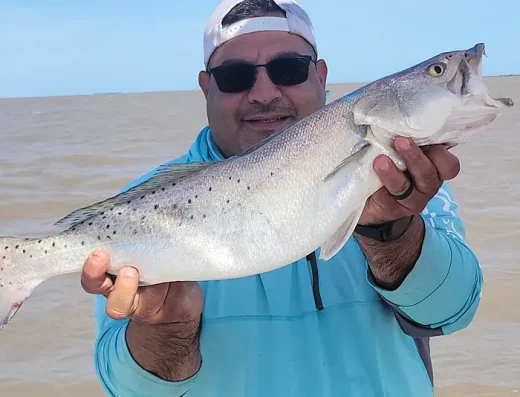Matagorda Fishing Charters
Matagorda fishing charters work the bays, jetties, and nearshore Gulf for redfish, speckled trout, flounder, and a mix of seasonal offshore species.
Top Rated Charters in Matagorda
TrustedFish connects anglers with proven local captains in Matagorda, Texas —no commissions, no pay-to-play listings, no BS. Every charter on our platform is invite-only, vetted for skill, local knowledge, and reputation. If they’re listed, they’ve earned it.
Matagorda, TX Fishing Guide
Matagorda sits where the Colorado River meets the Gulf of Mexico, giving anglers access to two distinct fisheries: the rich inshore bays and the deeper Gulf waters. Most charters here run either into East or West Matagorda Bay, both known for shell reefs, mud flats, and grassy shorelines that hold speckled trout and redfish year-round. Full-day bay trips usually stay within 5–15 miles of the dock, hitting multiple reefs, cuts, and shoreline stretches. Half-day trips are common for trout and reds, while nearshore and offshore runs target larger species when weather allows. Offshore charters may push 20–40 miles to chase kingfish, cobia, and snapper, with some bluewater runs going farther for mahi, wahoo, and even marlin in summer.
Key launch points include the Matagorda Harbor Marina and the public ramps along the Intracoastal Waterway. Seasonal changes shape the bite: spring brings trout to the mid-bay reefs and reds to the shorelines, summer heats up the surf and jetty action, fall offers some of the year’s best trout fishing on topwater, and winter keeps reds feeding deep in channels and warm-water pockets. Techniques range from live shrimp under popping corks to soft plastics on jig heads, trolling for pelagics, or soaking cut bait for bull reds at the jetties. Fly fishing guides also work the shallow flats in calmer conditions. If wind muddies the bays, some captains run to the surf or deeper channels to find cleaner water. Nearby options include the San Bernard River to the east or the lower Colorado River for freshwater-to-brackish action. Matagorda fishing stays consistent thanks to its variety of structure and the quick run times to fishable water.
Fishing Seasons in Matagorda
Spring (March–May)
As water temps climb, speckled trout start moving from deeper channels to mid-bay reefs, and redfish work the shorelines and back lakes. Live shrimp under popping corks and soft plastics over shell are staples. Offshore, kingfish and Spanish mackerel start showing on nearshore structure. Spring winds can be strong, so captains often tuck into protected bay areas. Half-day bay trips are popular for light tackle, while nearshore charters run when weather windows open.
Summer (June–August)
The surf bite comes alive, with trout and reds hitting live bait and topwaters early, then moving deeper as the sun gets high. Jetties produce bull reds, sharks, and Spanish mackerel. Offshore runs peak for snapper, kingfish, mahi, and occasional sailfish. Calm mornings make for productive fly fishing on the flats. Heat pushes some anglers to start early or fish evenings, and live croaker becomes the go-to bait for trout.
Fall (September–November)
Cooling temps trigger aggressive feeding. Big trout crush topwaters over reefs and shorelines, and redfish school in the surf and passes. Bull reds stack up at the jetties, making for heavy tackle battles. Offshore action remains solid for kingfish and snapper until the first strong cold fronts push through. Many charters focus on wade fishing in clear shallows or drifting shell reefs with live shrimp.
Winter (December–February)
Trout hold in deeper bay channels, drop-offs, and mud-bottom coves that retain warmth. Reds push into the rivers and deeper back lakes. Soft plastics worked slow along the bottom and live bait in deeper holes do the trick. Cold fronts limit offshore access, so most trips stay inside the bays. On calm, sunny days, sight fishing for reds in clear shallows can still be productive.
Gamefish in Matagorda
- Redfish – 20–40 lbs. Found along shorelines, jetties, and back lakes year-round; best in fall at the passes.
- Speckled Trout – 15–30 inches. Over reefs and grassy flats; topwater in fall, live croaker in summer.
- Flounder – 2–6 lbs. Around sandy points and channels in fall; gigging at night.
- Black Drum – 10–40 lbs. Deep channels and jetties in winter; shrimp or crab baits.
- King Mackerel – 10–30 lbs. Summer and fall offshore near rigs and structure; trolling spoons or ribbonfish.
- Spanish Mackerel – 2–6 lbs. Summer at jetties and nearshore rigs; small spoons and live bait.
- Snapper – 5–20 lbs. Offshore structure; summer season for red snapper, year-round for others.
- Shark – 50–150 lbs. Summer near the jetties and surf; cut bait on heavy tackle
Matagorda Fishing FAQs
Where do most fishing charters leave from in Matagorda?
Most charters launch from Matagorda Harbor Marina or public ramps along the Intracoastal Waterway, giving quick access to both bays and offshore routes.
What trip lengths are available for Matagorda fishing?
Half-day inshore trips run 4–5 hours, while full-day charters can stretch 8 hours or more. Offshore runs may require 10–12 hours depending on distance to the fishing grounds.
Is fishing gear provided on Matagorda charters?
Yes, most captains provide all rods, reels, tackle, and bait. You just need to bring a valid Texas fishing license, snacks, and drinks.
Do I need a fishing license to fish in Matagorda?
Yes, all anglers 17 and older need a Texas fishing license, with a saltwater endorsement for bay and Gulf fishing.
When is the best time to fish Matagorda?
Fall offers some of the best overall fishing, with active trout, redfish, and offshore species. Summer is prime for snapper and surf action.
What techniques are common on Matagorda charters?
Light tackle with live shrimp, wade fishing with soft plastics, trolling offshore, and bottom fishing for snapper and drum are standard methods.
What species can we expect inshore?
Inshore waters hold speckled trout, redfish, flounder, black drum, and seasonal sheepshead.
Can large groups book a Matagorda fishing trip?
Yes, many captains run bay boats for 4–6 anglers, and some can arrange multi-boat trips for larger groups.
Are specialty trips like night fishing or flounder gigging available?
Yes, several local guides offer seasonal flounder gigging trips at night, as well as summer evening trout and redfish charters.


